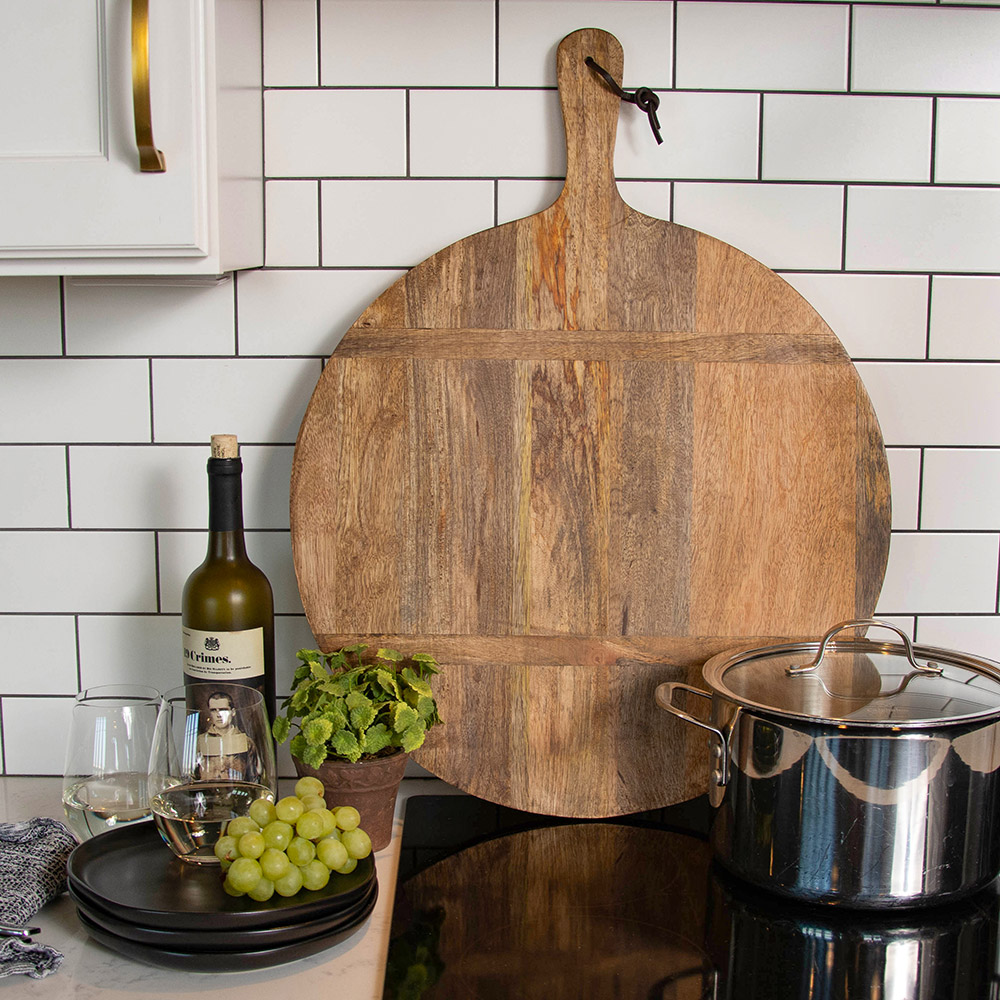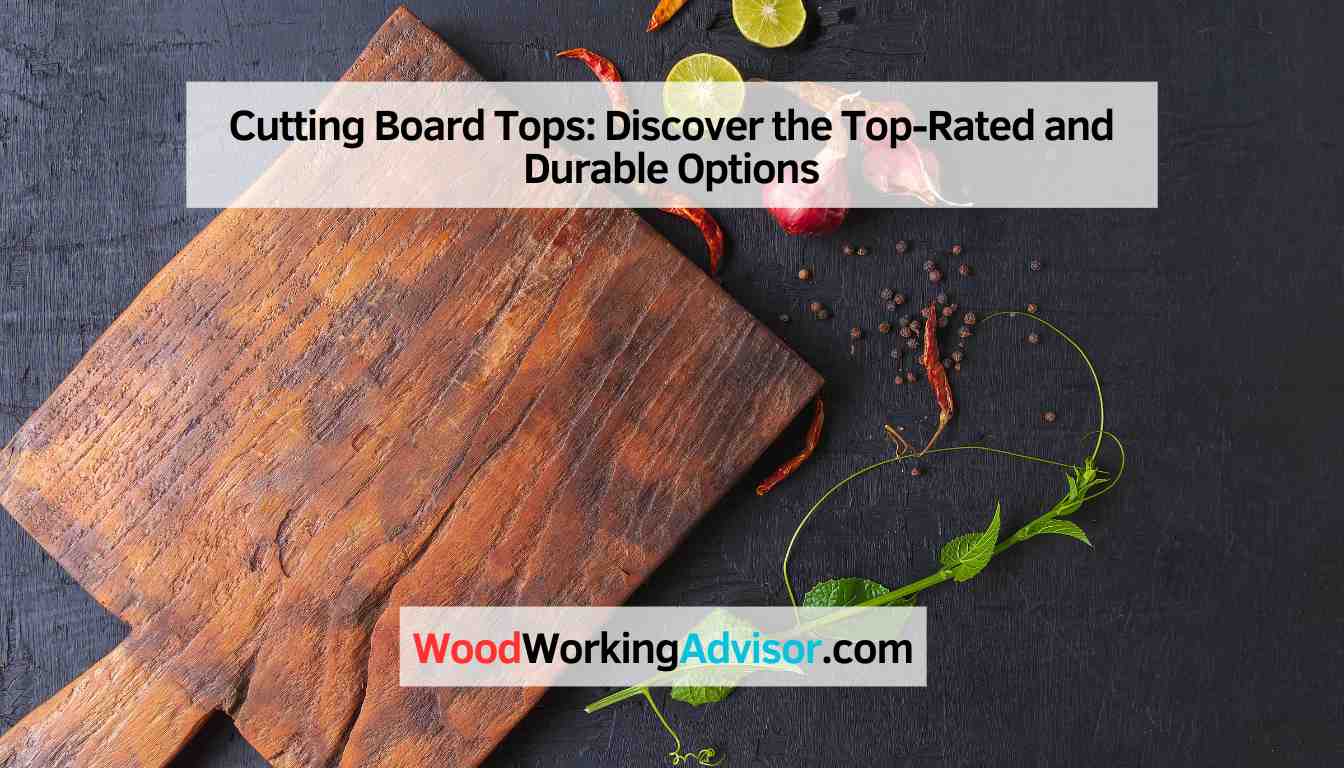Cutting board tops are essential for food preparation to prevent damage to countertops and ensure hygiene. A high-quality cutting board top is a must-have kitchen accessory for any cooking enthusiast.
Not only does it protect your countertops from scratches and damage, but it also helps maintain cleanliness and hygiene while chopping, slicing, and dicing ingredients. Investing in a durable and easy-to-clean cutting board top can enhance your cooking experience and prolong the life of your kitchen surfaces.
With various materials and designs available, choosing the right cutting board top can elevate your kitchen aesthetics and functionality. Whether you prefer wooden, plastic, or bamboo cutting boards, selecting the appropriate top is crucial for efficient meal preparation and a well-organized kitchen workspace.

Credit: www.homedepot.com
The Importance Of A Quality Cutting Board
Using a quality cutting board in your kitchen is essential for maintaining food safety and prolonging the life of your knives.
Avoiding Cross-contamination
A quality cutting board helps in preventing cross-contamination between different types of foods, such as raw meats and produce.
- Use separate cutting boards for raw meats and vegetables.
- Clean and sanitize your cutting board after each use.
- Replace cutting boards that are heavily scored or damaged.
Protecting Your Countertops
A good cutting board protects your countertops from scratches and damage that can occur when cutting directly on the surface.
- Choose a cutting board that is gentle on your countertops.
- Consider using silicone or wooden cutting boards for this purpose.
Top Features To Look For In Cutting Board Tops
A high-quality cutting board top is an essential tool in any kitchen. When choosing a cutting board top, it is important to consider key features that enhance functionality and durability. Let’s explore the top features to look for in cutting board tops:
Material Durability
Durable materials are vital for a cutting board top to withstand daily usage.
- Hardwoods like maple and oak provide excellent durability and resistance to wear.
- Bamboo is another eco-friendly, sturdy option known for its strength.
Ease Of Maintenance
Easy maintenance ensures the cutting board top remains hygienic and in top condition.
- Non-porous surfaces are easy to clean and resist bacterial growth.
- Dishwasher-safe cutting boards offer convenience for thorough cleaning.
Wooden Cutting Board Options
Wooden cutting boards are an essential kitchen tool for any home cook or professional chef. There are several options available, each with its own unique features and benefits. When it comes to wooden cutting boards, Maple Wood and Bamboo are among the most popular choices. Let’s explore the characteristics and advantages of each type of wooden cutting board to help you make an informed decision for your kitchen.
Maple Wood Cutting Boards
Maple wood cutting boards are renowned for their durability and strength. They are crafted from hard maple trees, which provide a dense and sturdy surface for chopping and slicing. The tight grain of maple wood helps prevent deep cuts and grooves, making it an excellent choice for preserving the sharpness of your knives. Additionally, maple wood has natural antimicrobial properties that inhibit the growth of bacteria, ensuring a hygienic food preparation surface.
Bamboo Cutting Boards
Bamboo cutting boards are a sustainable and eco-friendly option for your kitchen. Bamboo is a fast-growing grass that regenerates quickly, making it an environmentally conscious choice. The natural fibers of bamboo make it resistant to knife marks, and its non-porous surface is less likely to harbor bacteria. Bamboo cutting boards are also lightweight and easy to maintain, requiring simple cleaning with mild soap and water.
:max_bytes(150000):strip_icc()/__opt__aboutcom__coeus__resources__content_migration__serious_eats__seriouseats.com__2019__07__20190701-wood-cutting-boards-vicky-wasik-3-1-1500x1125-999280b71a7b4ef399a1c25c4f7dc179.jpg)
Credit: www.seriouseats.com
Plastic Cutting Board Options
Looking for functional and durable options for cutting board tops? Explore a range of plastic cutting boards that offer versatility and ease of maintenance. From antimicrobial properties to non-slip designs, these cutting boards provide a reliable and hygienic surface for all your chopping needs.
When it comes to choosing a cutting board, plastic options are a popular and practical choice. Plastic cutting boards are known for their durability, ease of maintenance, and affordability. Not only are they gentle on your knives, but they also provide a hygienic surface for preparing your meals. In this article, we will explore two popular options for plastic cutting boards: HDPE plastic cutting boards and flexible polyethylene cutting boards.
Hdpe Plastic Cutting Boards
HDPE, which stands for high-density polyethylene, is a versatile material used for a variety of applications. HDPE plastic cutting boards offer several advantages that make them a top choice among professional and home cooks alike. Here are some key benefits of HDPE plastic cutting boards:
1. Durable: HDPE plastic cutting boards are built to withstand heavy use. They are resistant to scratches, stains, and odors, ensuring a long lifespan for your cutting board.
2. Knife-friendly: The soft and slightly forgiving nature of HDPE plastic makes it gentle on your knife blades, minimizing damage and preserving their sharpness.
3. Hygienic: HDPE plastic is non-porous, meaning it won’t absorb juices, bacteria, or odors from the food you’re cutting. This makes cleaning a breeze and reduces the risk of cross-contamination.
4. Dishwasher safe: HDPE plastic cutting boards can be safely cleaned in the dishwasher, making them a convenient option for busy cooks.
Flexible Polyethylene Cutting Boards
If you’re looking for a cutting board that offers flexibility and versatility, then flexible polyethylene cutting boards might be the perfect choice for you. Here are some important features of flexible polyethylene cutting boards:
1. Bendable: Flexible polyethylene cutting boards are incredibly pliable, allowing you to bend and shape them as needed. This feature makes them ideal for tasks that require pouring or transferring chopped ingredients.
2. Lightweight: Unlike their rigid counterparts, flexible polyethylene cutting boards are lightweight and easy to handle. They are also easy to store as they can be rolled up or laid flat.
3. Non-slip surface: Many flexible polyethylene cutting boards are designed with a textured surface that prevents them from sliding around your countertop while you’re chopping.
4. Easy to clean: Cleaning flexible polyethylene cutting boards is a breeze. You can easily hand wash them with soap and water or toss them in the dishwasher for added convenience.
In conclusion, when it comes to plastic cutting board options, both HDPE plastic cutting boards and flexible polyethylene cutting boards offer unique advantages. Whether you prioritize durability, knife-friendliness, or the ability to bend and shape your cutting board, there is a plastic option that will meet your needs. Take your pick and enjoy the benefits of a reliable and hygienic cutting surface in your kitchen.
Other Materials To Consider
When it comes to cutting boards, most people are familiar with the classic wooden cutting board. However, there are other materials to consider that may suit your needs and preferences. Whether you are looking for something stylish, durable, or easy to clean, exploring different cutting board materials can enhance your cooking experience.
Glass Cutting Boards
Glass cutting boards are a popular choice for those who prioritize hygiene and easy maintenance. With their smooth, non-porous surface, these cutting boards are resistant to stains and odors. They are also dishwasher-safe, making cleanup a breeze. Glass cutting boards can add a modern touch to your kitchen decor, as they are available in various colors, patterns, and designs. However, it is important to note that glass can be hard on your knives, causing them to dull faster.
Composite Cutting Boards
Composite cutting boards are constructed using a combination of materials such as plastic, wood fibers, or resin. These boards offer the best of both worlds, providing the durability of plastic and the natural appearance of wood. They are dishwasher-safe and resistant to moisture, ensuring long-lasting performance. Composite cutting boards are also gentle on your knives, preserving their sharpness. Available in a range of colors and sizes, they can complement any kitchen decor.
- Hygienic and easy to clean
- Dishwasher-safe
- Durable and resistant to stains
- Can add a stylish touch to your kitchen
Considering alternative materials for your cutting board can open up a world of possibilities. Glass cutting boards offer a sleek and modern aesthetic, while composite cutting boards combine durability and natural appeal. Whichever material you choose, make sure to prioritize your needs and preferences to find the perfect cutting board for your kitchen.
Frequently Asked Questions Of Cutting Board Tops
How Do I Choose The Right Cutting Board Top?
Choosing the right cutting board top involves considering factors such as material, durability, maintenance, and appearance. Look for options like bamboo or plastic that are easy to clean and gentle on knife blades. Consider size and thickness based on your culinary needs and storage space.
What Are The Benefits Of Using A Cutting Board Top?
Using a cutting board top helps prevent cross-contamination between different food items and protects your countertop from scratches. It also provides a stable surface for safe and efficient food preparation. With proper care, a cutting board top can last for years, making it a durable and cost-effective kitchen tool.
How Do I Clean And Maintain A Cutting Board Top?
To clean and maintain a cutting board top, use warm soapy water and a non-abrasive sponge or cloth. If needed, you can also use a mixture of vinegar and water for sanitizing purposes. Avoid soaking the board and dry it thoroughly after washing to prevent warping.
Regularly oil wooden cutting boards to maintain their condition.
Conclusion
Choosing the right cutting board top is essential for a functional and stylish kitchen. With the wide array of options available, it’s important to consider the material, size, and maintenance requirements to find the perfect fit for your needs. Whether you opt for wood, plastic, or bamboo, a well-chosen cutting board top can enhance your cooking experience and contribute to a beautiful, organized kitchen space.


